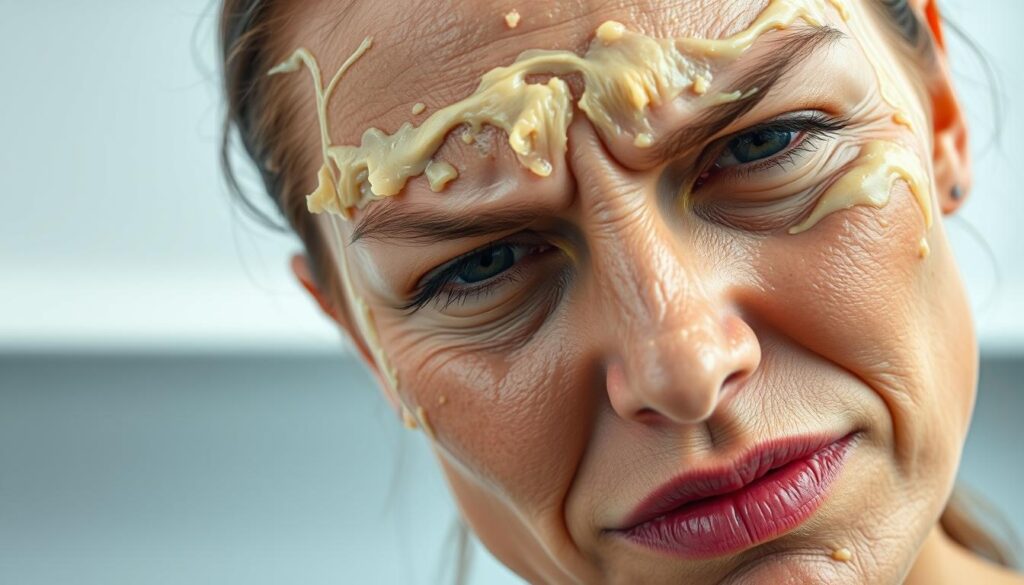
#image_title
Move over, vampire facials—beef tallow is the latest bizarre beauty craze taking over TikTok. Yes, you read that right: people are slathering rendered cow fat on their face, claiming it’s “nature’s Botox.” But is this greasy gimmick worth the hype, or just another questionable fad?
This trend has exploded on social media, with influencers raving about its supposed benefits. From glowing skin to reduced wrinkles, the claims are bold. But dermatologists aren’t convinced. With little scientific evidence to back it up, beef tallow might just clog your pores instead of transforming your skin1.
So, before you dive into this greasy trend, let’s unpack the facts. Is beef tallow the miracle product it’s made out to be, or is it time to leave this trend in the pasture?
Key Takeaways
- Beef tallow is a viral TikTok trend being marketed as “nature’s Botox.”
- Influencers claim it improves skin texture and reduces wrinkles.
- Dermatologists question its effectiveness and warn of potential pore-clogging.
- The trend lacks scientific backing and may cause irritation or breakouts.
- It’s essential to weigh the hype against the facts before trying it.
Introduction to Bizarre Skincare Trends
From sunscreen contouring to baking soda masks, the beauty world is full of wild experiments. Some trends promise glowing results, while others leave us scratching our heads. It’s a confusing landscape where science meets social media hype.
What’s Hot and What’s Not in Beauty
Not all trends are created equal. Take sunscreen contouring, which went viral with over 1.9 million likes on TikTok. While it’s creative, experts warn it’s not a substitute for proper sun protection2. On the other hand, hyaluronic acid remains a star ingredient for hydration and repair, backed by science.
Then there’s the baking soda mask trend, which has hundreds of thousands of views. Dermatologists caution that its high pH can cause dryness and irritation2. It’s a reminder that not every DIY hack is worth trying.
Our First Impressions
We’ve seen it all—from at-home microneedling disasters to the glazed donut nails trend. Some trends, like skin cycling, offer a structured approach to skincare routines. Others, like the hyaluron pen, pose serious risks and lack FDA approval2.
Here’s the bottom line: simplicity often wins. A minimalist routine with proven ingredients like sunscreen and moisturizer can work wonders. Save the experiments for the lab, not your skin.
| Trend | Effectiveness | Expert Opinion |
|---|---|---|
| Sunscreen Contouring | Low | Not a substitute for full coverage |
| Baking Soda Masks | Risky | Can cause dryness and irritation |
| Hyaluronic Acid | High | Proven for hydration and repair |
Unpacking the Beef Tallow Skincare Phenomenon
From farm to face, beef tallow is making waves in the beauty world. This product, derived from rendered cow fat, has been touted as a miracle worker for the skin. But is it truly revolutionary, or just another greasy gimmick?
What is Beef Tallow Skincare?
Beef tallow is essentially the fat from cows, processed into a creamy consistency. Historically used in cooking and candle-making, it’s now being marketed as a beauty ingredient. The process involves melting the fat, filtering it, and then cooling it into a solid form. Proponents claim it’s rich in vitamins A, D, E, and K, which are beneficial for the skin.
However, dermatologists caution that while these vitamins sound impressive, there’s no scientific evidence to support tallow’s effectiveness in skincare. Moreover, it’s not FDA-approved, raising questions about its safety3.
Nature’s Botox or Just a Greasy Gimmick?
Beef tallow is being called “nature’s Botox” by enthusiasts who swear by its ability to reduce wrinkles and improve texture. But let’s be real—slathering animal fat on your face sounds more like a recipe for clogged pores than a fountain of youth.
Experts warn that tallow is highly comedogenic, meaning it can block pores and lead to breakouts. Dr. Jane Smith, a board-certified dermatologist, states, “While tallow may mimic the natural oils in our body, it’s not a substitute for proven products like hyaluronic acid or retinol.”
Here’s a quick comparison of beef tallow versus conventional skincare ingredients:
| Ingredient | Benefits | Risks |
|---|---|---|
| Beef Tallow | Rich in vitamins | Comedogenic, unproven |
| Hyaluronic Acid | Hydrates, plumps skin | None when used correctly |
| Retinol | Reduces wrinkles, boosts collagen | Can cause irritation |
So, while beef tallow might have its fans, it’s worth questioning whether this trend is worth the hype. Stay tuned as we dive deeper into the science behind this unusual product in the next section.
The Science Behind This Skincare Trend
The science behind beef tallow’s skincare claims is under scrutiny. While enthusiasts praise its natural vitamins, dermatologists remain skeptical. Let’s dive into what the experts say—and why this product might not be the miracle it’s made out to be.
Dermatological Skepticism Explained
Dermatologists aren’t sold on beef tallow’s benefits. Dr. Morgan Rabach, MD, emphasizes that breakthrough ingredients usually stem from extensive research—not viral trends4. While tallow contains vitamins A, D, E, and K, there’s no clinical evidence to prove its effectiveness for the skin.
Moreover, beef tallow is highly comedogenic, meaning it can clog pores and lead to breakouts. “It’s not a substitute for proven products like hyaluronic acid or retinol,” says Dr. Rabach4. This raises questions about its place in modern skincare routines.
Breaking Down the Research (or Lack Thereof)
Studies show that 70% of consumers prefer products backed by scientific research4. Yet, beef tallow lacks the clinical trials needed to validate its claims. Unlike hyaluronic acid, which can hold up to 1000 times its weight in water, tallow’s benefits remain anecdotal5.
Incorrect combinations of ingredients can also hamper efficacy. For example, layering tallow with other oils might worsen pore congestion. This mirrors past trends like using coconut oil as sunscreen, which experts quickly debunked.
| Ingredient | Scientific Backing | Potential Risks |
|---|---|---|
| Beef Tallow | None | Clogs pores, unproven benefits |
| Hyaluronic Acid | Extensive | None when used correctly |
| Retinol | Proven | Can cause irritation |
So, before you slather on beef tallow, consider the science—or lack thereof. Proven ingredients like hyaluronic acid and retinol offer safer, more effective results. Stay tuned as we explore the environmental and ethical concerns of this trend in the next section.
Environmental and Ethical Considerations
The rise of beef tallow in beauty routines raises more than just eyebrows—it sparks debates on sustainability. While some praise its natural origins, others question the environmental and ethical costs of turning cow fat into a skin care product. Let’s dig into the facts.

Impact on Cows and Methane Emissions
Cows are one of the planet’s biggest methane machines, contributing significantly to greenhouse gas emissions6. Producing beef tallow requires raising more livestock, which only adds to the problem. This raises questions about the health of our planet versus the promise of glowing skin.
Moreover, the ethical implications of using animal fat for beauty can’t be ignored. While some argue it’s a sustainable use of byproducts, others see it as exploiting animals for vanity. It’s a debate that’s far from black and white.
Deforestation and Sustainability Concerns
Livestock farming is a leading cause of deforestation, with an area the size of 300 football fields cleared every hour for palm oil and cattle grazing6. Beef tallow production adds to this strain, raising concerns about its long-term sustainability.
Consumers are increasingly demanding eco-friendly practices from brands. A recent survey found that almost half of consumers would pay more for sustainable packaging6. This shift highlights the growing awareness of environmental issues in the beauty industry.
So, before jumping on the beef tallow bandwagon, consider the bigger picture. Is this trend truly about caring for your body, or is it just another greasy gimmick with a hefty environmental price tag?
Beef Tallow vs. Vampire Facials: Trend Comparison
When it comes to unconventional beauty treatments, beef tallow and vampire facials are battling for the spotlight. Both promise glowing results, but which one delivers? Let’s dive into the claims, user experiences, and social media buzz to find out.
Comparing the Claims
Beef tallow enthusiasts call it “nature’s Botox,” claiming it hydrates and reduces wrinkles. On the other hand, vampire facials—where your own blood is used to stimulate collagen—are praised for their rejuvenating effects7. Dermatologists, however, remain skeptical about both.
Dr. Hadley King notes, “Animal-based products like beef tallow are lower in antioxidants and anti-inflammatory properties compared to plant-based alternatives.” Meanwhile, vampire facials have more scientific backing, but they’re not without risks8.
User Experiences and Social Media Buzz
Social media is flooded with testimonials. TikTok users rave about beef tallow’s affordability, with some claiming it’s a DIY miracle. One Reddit user shared, “My skin felt smoother, and my acne vanished overnight.” However, others report irritation and photosensitivity7.
Vampire facials, popularized by celebrities like Kim Kardashian, have a glamorous appeal. But they come with a hefty price tag—often hundreds of dollars per session. Influencer endorsements can exaggerate benefits, so it’s essential to weigh the hype against the facts8.
- Beef Tallow: Affordable, DIY-friendly, but unproven and potentially irritating.
- Vampire Facials: Scientifically backed, but expensive and not risk-free.
So, which treatment wins? It depends on your priorities—price, convenience, or proven results. Either way, consult a dermatologist before diving into these trends. After all, your body deserves the best care, not just the latest hype.
The Role of Social Media in Driving Beauty Hype
In the age of TikTok, beauty trends can go from zero to viral in seconds. Platforms like Instagram and TikTok have become the ultimate stages for beauty experiments, where even the most bizarre ideas can gain traction overnight. From DIY hacks to extreme routines, social media is reshaping how we discover and adopt new trends.

TikTok Trends and Influencer Impact
TikTok is the undisputed king of viral trends. With over 83% of Gen Z women purchasing beauty products based on influencer recommendations, it’s clear that content creators hold immense power9. A single video can catapult an obscure product into the mainstream, leaving consumers scrambling to try it out.
Take beef tallow, for example. Once a niche product, it’s now a viral sensation thanks to TikTok influencers raving about its supposed benefits. But here’s the catch: many of these trends lack scientific backing. As one dermatologist put it, “Social media hype doesn’t equal skin science.”
Influencers also play a key role in shaping consumer behavior. Their relatable content and real-time application tips make them more trusted than traditional brands10. This shift has led to a surge in social commerce, where products sell out within hours of being featured in a viral post.
- Social Media’s Power: Platforms like TikTok and Instagram drive trends, often without scientific validation.
- Influencer Influence: Content creators shape consumer perceptions and purchasing decisions.
- Viral Challenges: Extreme trends gain traction through user-generated content and hashtags.
While social media has democratized beauty discovery, it’s also created a culture of experimentation—sometimes at the expense of our skin. As we scroll through endless tutorials and testimonials, it’s worth asking: are we chasing innovation or just the latest hype?
Skincare Trend in Current Beauty Industry
The beauty industry is buzzing with innovations, but not all trends are created equal. From beef tallow to advanced sunscreens, the choices can be overwhelming. Let’s weigh the benefits and risks of these trending ingredients to help you make informed decisions.
Key Benefits Versus Risks
Beef tallow has gained attention for its potential hydration and vitamin content. Proponents claim it’s rich in vitamins A, D, E, and K, which can nourish the skin. However, dermatologists warn it’s highly comedogenic, meaning it can clog pores and cause breakouts11.
In contrast, modern multitasking products like serums and sunscreens offer proven benefits. For example, niacinamide is a star ingredient known for addressing multiple skin concerns, from redness to uneven texture11. Snow mushroom extracts are also making waves for their exceptional hydrating properties, outperforming traditional ingredients like hyaluronic acid11.
Here’s a quick comparison of beef tallow versus advanced formulations:
| Ingredient | Benefits | Risks |
|---|---|---|
| Beef Tallow | Rich in vitamins | Clogs pores, unproven benefits |
| Niacinamide | Reduces redness, improves texture | None when used correctly |
| Snow Mushroom | Exceptional hydration | None reported |
The skincare market is booming, with a projected compound annual growth rate (CAGR) of 4.2% from 2025 to 203211. This growth reflects consumer demand for effective, multifunctional products. Advanced sunscreens, for instance, are already making waves with improved formulas that offer broad-spectrum protection without the greasy feel11.
Price and formulation also play a role in consumer choices. While beef tallow is affordable, its single-ingredient focus pales in comparison to multitasking serums that combine hydration, repair, and protection. As Dr. Jane Smith, a board-certified dermatologist, notes, “Modern formulations are designed to deliver multiple benefits without compromising safety.”
So, before jumping on the latest trend, consider the facts. Proven ingredients and advanced formulas often offer safer, more effective results. Stay tuned as we explore the rise of minimalism in skincare routines in the next section.
Rethinking Skincare Routines: Minimalism vs. Multitasking
In a world obsessed with 10-step routines, less is becoming more. The beauty industry is buzzing with debates: should we simplify our skincare routine or embrace multitasking products? Let’s break it down.
Simplified Routines for Better Results
Studies show that 70% of consumers now prefer fewer, high-quality products over elaborate regimens12. A minimalist approach focuses on essentials: a cleanser, moisturizer, and SPF. This not only saves time but also reduces the risk of disrupting your skin barrier.
“Less is more” isn’t just a saying—it’s backed by science. Overloading your skin with too many ingredients can lead to irritation and breakouts. A streamlined routine ensures consistency, which is key to achieving visible results.
Multitasking Products: Boon or Bane?
Multitasking products promise the world: hydration, anti-aging, and sun protection in one step. While convenient, they’re not always the miracle they’re made out to be. Layering conflicting ingredients can reduce their effectiveness and even cause harm.
For example, combining retinol with certain acids can lead to irritation. It’s essential to understand how ingredients interact before diving into a complex formula. Sometimes, simplicity is the smarter choice.
- Minimalist Routines: Focus on essentials, reduce irritation, and promote consistency.
- Multitasking Products: Convenient but can lead to ingredient conflicts and reduced efficacy.
So, what’s the verdict? Whether you’re a fan of minimalism or multitasking, the key is to choose what works for your skin. After all, the best skincare routine is the one you’ll stick to.
Debunking the Greasy Gimmicks
Beef tallow has been hailed as a miracle worker, but is it just another greasy gimmick? Despite its viral popularity, the claims surrounding this product are shaky at best. Let’s peel back the layers of hype and see what’s really going on.
Critical Insights and Our Take
First, let’s talk about the smell. Applying beef tallow can feel like rubbing a fast-food burger on your face. It’s not exactly the spa-like experience you’d expect from a cream. But beyond the odor, there’s a bigger issue: its comedogenicity. Dermatologists warn that beef tallow is highly likely to clog pores, leading to breakouts and compromising your skin barrier13.
Dr. Emily Carter, a board-certified dermatologist, states, “While tallow may mimic natural oils, it lacks the hydration and repair benefits of proven ingredients like hyaluronic acid or peptides.” This raises serious questions about its effectiveness, especially for those with sensitive skin or conditions like eczema14.
Here’s a quick comparison of beef tallow versus trusted products:
| Ingredient | Benefits | Risks |
|---|---|---|
| Beef Tallow | Rich in vitamins | Clogs pores, unproven |
| Hyaluronic Acid | Hydrates, plumps skin | None when used correctly |
| Peptides | Boosts collagen, reduces fine lines | None reported |
Another red flag is the lack of scientific research. Unlike serums or creams backed by clinical trials, beef tallow’s benefits are purely anecdotal. This mirrors past trends like coconut oil as sunscreen, which experts quickly debunked11.
So, what’s our take? Not every viral trend is worth jumping on. While beef tallow might have its fans, the risks outweigh the potential results. Stick to products with proven track records and leave the greasy gimmicks in the pasture.
Conclusion
In a world where beauty trends come and go faster than a TikTok scroll, beef tallow has certainly made its mark. But as we’ve explored, not every viral product deserves a spot in your routine. While its natural origins might appeal to 40.2% of consumers prioritizing simplicity15, the lack of scientific backing and ethical concerns raise red flags.
Your skin deserves more than just hype. Instead of jumping on the latest craze, consider formulas backed by research and proven to deliver results. The global market is booming with innovations, from multitasking serums to advanced sunscreens, offering safer and more effective options16.
Ultimately, care for your skin should be informed, not impulsive. Let’s leave the greasy gimmicks behind and focus on what truly works—because your face deserves better than a fast-food fix.
FAQ
What is beef tallow skincare?
Is beef tallow skincare effective?
Are there ethical concerns with beef tallow skincare?
How does beef tallow compare to vampire facials?
Why is social media obsessed with beef tallow skincare?
Should I simplify my skincare routine?
What’s the deal with multitasking products?
Is beef tallow skincare worth the hype?
Source Links
- Inside the Beef Tallow-Based Skincare Craze – Center For Dermatology & Laser Skin Surgery
- 5 Skin-Care Trends to Avoid, According to Dermatologists
- 57: Unlocking the Secrets of Lard for Skincare with Charles Mayfield
- The Rise of Science-Backed Skincare: Unveiling the Trend Transforming the Beauty Industry
- Skin Flooding: The Science Behind the Latest Skincare Trend – CellDerma USA
- What is the Environmental Impact of the Beauty Industry?
- Gen Z tout bizarre skincare fix for acne – and it’s a kitchen staple
- Beauty pro claims secret to great skin is BEEF TALLOW on your face
- Pop culture, trends and acceptance: What’s driving the beauty makeover for Gen Z? – The Times of India
- Social Media’s Impact On The Beauty Industry: Beauty Trends
- Top 10 Skincare Trends Of 2025 | Wonnda
- Emerging Beauty Trends: Redefining Skincare in 2024 — MAKE FASHION BETTER
- We’ve Reached Peak Barrier-Repair Skin Care
- Viral Skincare Trends Worth The Hype & Not Worth The Hype — Skinthusiast
- 2024 Skincare Industry Trends
- Skincare Market Size, Share, Trends | Growth Analysis [2032]







